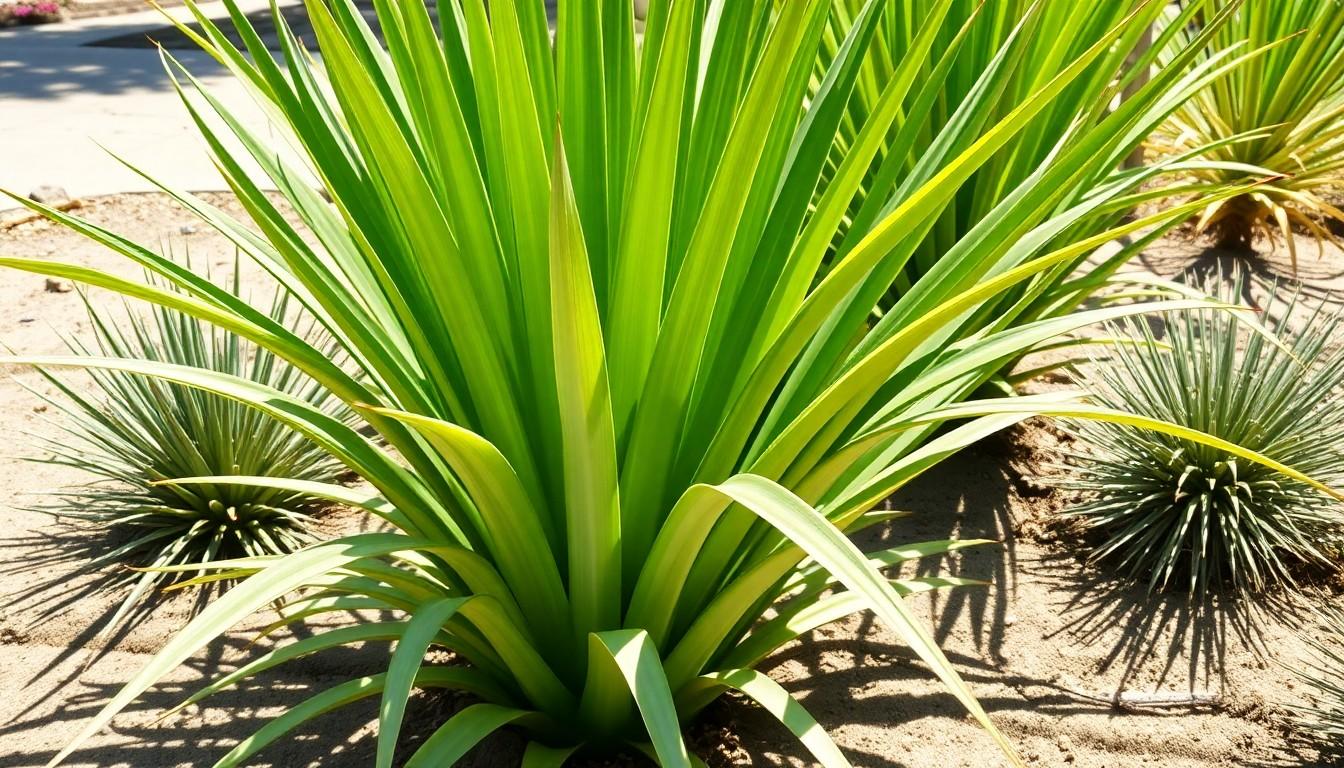If you’re looking to add a touch of the exotic to your garden, the outdoor yucca plant is your go-to green companion. With its striking sword-like leaves and bold architectural form, it’s like the rock star of the plant world—low-maintenance yet undeniably eye-catching. But don’t let its tough exterior fool you; even the most resilient yucca needs a little TLC to thrive.
Understanding Yucca Plants
Yucca plants offer unique features that enhance outdoor spaces. Known for their stunning aesthetics and resilience, these plants make an excellent addition to gardens.
Types of Yucca Plants
Numerous yucca species exist, each with distinct characteristics. Yucca filamentosa, also called Adam’s needle, has long, narrow leaves and produces white flowers. Another option is Yucca gloriosa, also known as Spanish bayonet, recognized for its taller growth and robust flowering. Yucca brevifolia, the Joshua tree, stands out with its tree-like form and unique branching structure. Select a type based on desired height and flower color for optimal landscape effects.
Benefits of Growing Yucca Outdoors
Growing yucca outdoors enables gardeners to benefit from several advantages. Low water requirements contribute to their drought resistance, making maintenance straightforward. Pest resistance ensures fewer interventions are needed, saving time and effort. Hardy in various climates, yucca plants thrive in both hot and cold regions. Additionally, attractive foliage offers visual interest year-round, while large blooms provide spectacular seasonal displays.
Basic Outdoor Yucca Plant Care

Caring for outdoor yucca plants requires awareness of their specific needs. These hardy plants thrive with the right attention to their growth conditions.
Ideal Growing Conditions
Yucca plants prefer full sun exposure, ensuring they receive at least six hours of direct light daily. Well-draining soil is crucial for preventing root rot, so sandy or rocky substrates work best. Planting in a location that experiences minimal frost helps the yucca flourish through colder months. Species like Yucca filamentosa tolerate various soil types, while Yucca gloriosa thrives in coastal environments. Mature yucca plants can adapt to drought conditions, making them suitable for arid climates.
Watering Guidelines
Established yucca plants require infrequent watering to maintain health. Watering should occur every two weeks during the growing season, allowing the soil to dry between sessions. Overwatering can lead to root rot, so checking the top inch of soil for dryness before watering is essential. During winter months, reduce watering to once a month, depending on local humidity. Newly planted yuccas benefit from more frequent watering to establish roots, ensuring their long-term vitality and resilience.
Soil and Fertilization
Yucca plants thrive in specific soil conditions, making soil selection crucial for their growth. Well-draining soil is essential to prevent root rot. Sandy or rocky soil types work best, as they allow excess water to escape quickly. A pH level between 6.0 and 7.5 enhances nutrient availability, promoting overall plant health.
Best Soil Types for Yucca
Sandy loam stands out as an ideal choice, providing a balance of drainage and moisture retention. Gravelly soil also supports yucca plants, facilitating excellent drainage while maintaining adequate aeration. If using potting mix, select one designed for succulents, ensuring low organic matter and effective drainage. Incorporating coarse sand or perlite improves soil structure, enhancing performance in varied climatic conditions.
Fertilizing Yucca Plants
Fertilization should occur during the growing season, specifically in spring and summer. A balanced, slow-release fertilizer with equal parts nitrogen, phosphorus, and potassium offers optimal nutrition. Applying fertilizer every four to six weeks supports healthy growth. Yucca plants generally thrive without frequent fertilization, making over-fertilization unnecessary. In winter, ceasing fertilizer applications aligns with the plant’s dormant phase, avoiding potential root damage.
Pruning and Maintenance
Effective pruning and maintenance enhance the health and structure of outdoor yucca plants. Regular care encourages growth and maintains their striking appearance.
When to Prune Yucca
Timing for yucca pruning occurs during spring and early summer. Young plants thrive with occasional pruning to remove dead or damaged leaves. Established yuccas benefit from annual maintenance to shape the plant and encourage new growth. Avoid pruning in fall or winter, as it could stress the plant and impair its winter hardiness. Pruning right before the active growing season promotes healthy foliage and overall vitality.
Tools for Pruning
Essential tools for yucca pruning include sharp, clean pruning shears and gloves. Shears allow precise cuts while protecting the plant’s health. Opt for long-handled loppers to remove thicker stems or leaves. Using gloves safeguards hands from the plant’s sharp edges. Regular cleaning of tools prevents the spread of disease and ensures smooth cuts, promoting optimal healing for the plant.
Common Pests and Diseases
Outdoor yucca plants can face various pests and diseases that may affect their health.
Identifying Common Pests
Scale insects often appear on yucca plants, occasionally causing leaf yellowing and wilting. Aphids may also infest, creating a sticky residue on leaves. Examine plants regularly for webbing, indicating a spider mite presence. Thrips can result in silvery streaks on leaves and stunted growth. Contacting a horticulturist helps to identify specific pests and ensure proper treatment measures.
Preventing and Treating Diseases
Root rot presents a significant threat to yucca plants, primarily due to overwatering and poorly draining soil. Look for signs such as yellowing leaves and a foul smell from the roots. Fungal infections like leaf spots can develop in humid conditions, resulting in discolored foliage. Applying fungicides serves as a solution for treating infections, while maintaining soil drainage prevents initial issues. Proper spacing between plants promotes airflow, minimizing disease risk.
Conclusion
Outdoor yucca plants can transform any garden into a stunning oasis with minimal effort. Their unique appearance and resilience make them a favorite among gardeners seeking both beauty and practicality. By understanding their specific needs for sunlight, soil, and water, anyone can cultivate these hardy plants successfully.
Regular maintenance and vigilance against pests will ensure yuccas thrive for years to come. With the right care, these plants not only enhance outdoor spaces but also provide year-round interest. Embracing yucca plant care is a rewarding journey that brings vibrant life to any landscape.

